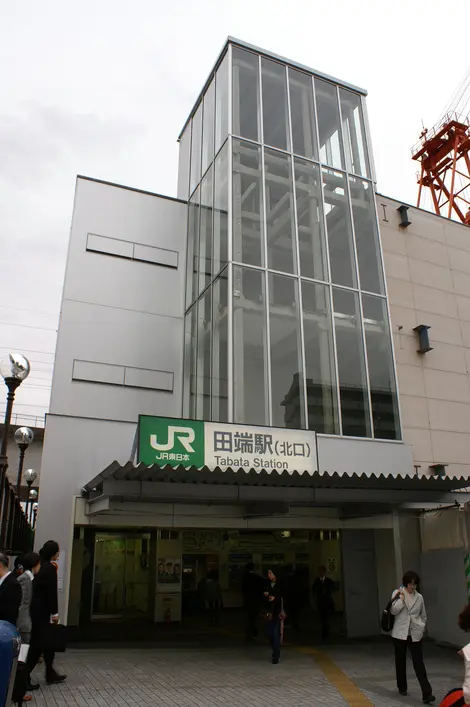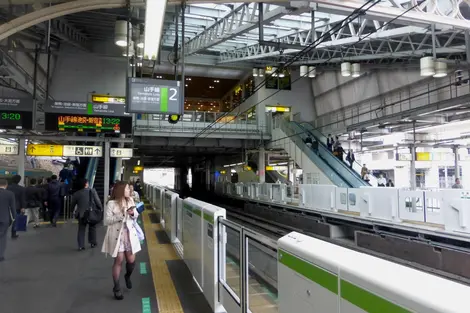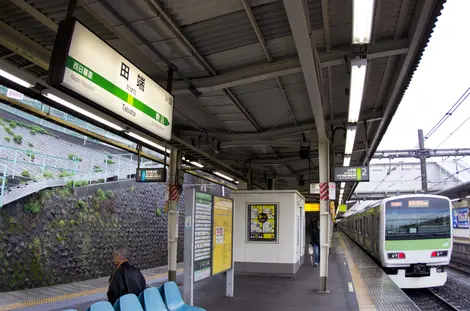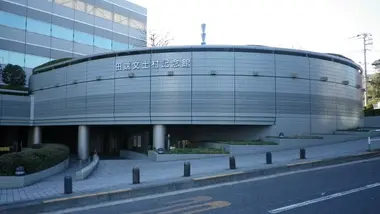Tabata station
Nestled in the heart of Tokyo's northern Kita district, Tabata 田端駅 (Tabata-eki) station is much more than just a transit point. This railway junction, served by the Yamanote and Keihin-Tōhoku lines, is the gateway to a district rich in history and culture. Since its inauguration on April 1, 1896, Tabata has preserved its old-world charm while adapting to modern times. With its artistic past, cultural attractions and strategic position on the Yamanote line, Tabata station offers travelers a unique experience in the heart of Japan's capital.
History and location of Tabata station
Tabata station has a rich history dating back over a century. Inaugurated on April 1, 1896, it has witnessed many changes in Tokyo's urban landscape. Located in Kita district, in the north of the capital, Tabata occupies a strategic position on the Yamanote circular line, between Komagome and Nishi-Nippori stations.
The Tabata district survived the Kanto earthquake of 1923, but was totally destroyed by bombing during the Second World War. Despite these hardships, it has retained its soul as a quiet, artistic district. The essence of Tabata is rooted in its past as a rural village where many craftsmen lived. Its proximity to the Tokyo School of Fine Arts (now Tokyo University of the Arts) has helped maintain its artistic roots to the present day.
Lines serving Tabata station
Tabata station is served by two main lines operated by JR East:
- The Yamanote line: This iconic line loops around Tokyo, connecting the capital's main centers of activity. Discover the Yamanote, Tokyo's iconic subway line, which provides easy access to major stations such as Shinjuku Station, Ueno Station and Akihabara Station.
- The Keihin-Tōhoku line: This line connects the cities of Saitama, Kawaguchi, Tokyo, Kawasaki and Yokohama, offering fast connections to other major urban areas.
Tabata is a medium-sized station with two platforms serving four tracks. Its position on these two major lines makes it an important transit point for travellers in and around Tokyo.
ATRE shopping center at Tabata station
At the station's northern exit, travelers will discover the ATRE shopping mall, a modern structure built around and above the station. Like the one at Akihabara station, Tabata ATRE offers an impressive variety of stores and restaurants.
Among the brands present are:
- A bakery and patisserie for sweet tooths
- A konbini for last-minute shopping
- A bento store for a quick, typically Japanese meal
- Restaurants offering a variety of cuisines: Japanese, Korean, Italian
- A large Starbucks for coffee lovers
- A Tsutaya bookshop for avid readers
This shopping center brings a modern and practical touch to the historic station, offering travelers and local residents a convivial space to dine, shop or simply relax before or after their journey.
The Tabata district: a haven for artists and writers
The Tabata district has long been a haven for artists and writers, attracting many creative talents over the years. This artistic reputation was forged by its proximity to the Tokyo School of Fine Arts (now Tokyo University of the Arts), which attracted young artists to the area.
Among the emblematic figures to have resided in Tabata is Ryunosuke Akutagawa, considered the "father of Japanese short stories and fiction". His work inspired the Oscar-winning film "Akira Kurosawa Rashomon" in 1950. The presence of these artists and writers helped create a unique and inspiring atmosphere in the neighborhood.
Sadly, Tabata's decline as an artistic community began in 1927 with Akutagawa's suicide. Despite this, the neighborhood's artistic legacy endures, attracting art and literature lovers to this day. Five well-known Japanese authors left their mark in this district, contributing to its rich cultural heritage.
Cultural attractions around Tabata Station
The Tabata district is packed with fascinating cultural attractions, testifying to its rich artistic and historical past. Here are a few must-see places to visit around the station:
- Tabata Memorial Museum of Writers and Artists (Tabata Bunshi Mura Kinenkan): Located just a two-minute walk from the station, this museum exhibits over 3,000 works by writers, painters and potters. It's an ideal place to discover Tabata's artistic heritage. Open free of charge every day from 10 a.m. to 4.30 p.m.
- Tôkan Mori Inari Shrine: Just a few minutes' walk from the station, this charming shrine houses a miniature version of the famous red Torii path at Kyoto's Fushimi Inari Shrine.
- Kami Tabata Hachiman Shrine and Togaku-ji Temple: These two religious edifices, side by side, offer a glimpse into the district's spiritual history. Although founded in 1491 and 1189 respectively, most of the current buildings were rebuilt after the Second World War.
These attractions allow visitors to immerse themselves in Tabata's rich history and culture, offering a unique experience in the heart of Tokyo. Right next door, discover Ueno Park to complete your cultural exploration of the area.
Tabata station on the Yamanote line: location and connections
Tabata station occupies a strategic position on the Yamanote Line, one of Tokyo's busiest train lines. Situated between Komagome and Nishi-Nippori stations, Tabata is an important transit point for many travelers.
On the Yamanote line, Tabata is connected to several major stations, including :
- Tokyo station: the central hub for many lines, including Shinkansen
- Ueno station: famous for its park and museums
- Akihabara station: a paradise for fans of Japanese pop culture
- Shinjuku station: one of the busiest stations in the world
- Ikebukuro station: a major commercial and cultural center
What's more, the Keihin-Tōhoku line offers direct connections to cities such as Saitama to the north and Yokohama to the south, expanding travel options for travelers.
Practical information for travelers
To make the most of your visit to Tabata station and the surrounding area, here's some practical information:
- Opening hours: Tabata station, like most stations on the Yamanote line, is open from 4:30 am to around 1:20 am. Trains run frequently, with intervals of 2 to 4 minutes during rush hours.
- Accessibility: The station is equipped with elevators and ramps to facilitate access for people with reduced mobility.
- Services: In addition to the ATRE shopping center, the station has vending machines, luggage lockers and public toilets.
- Connections: Don't forget that you can easily connect to other major lines like the Discover the Yamanote to explore other parts of Tokyo.
- Nearby attractions: Plan your visit to include the Tabata Memorial Museum of Writers and Artists, the Tôkan Mori Inari Shrine, and perhaps a stroll through the neighborhood to absorb its unique artistic atmosphere.
Whether you're a traveler in transit or a tourist exploring Tokyo, Tabata Station offers an experience rich in history and culture. Don't hesitate to take the time to discover this fascinating district, a witness to the evolution of the Japanese capital over the decades.
Address, timetable & access
Address
Timetable
JR East's Yamanote and Keihin-Tōhoku lines.












































